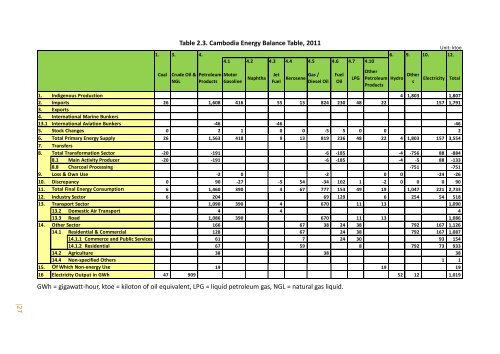RPR_FY2015_08
Create successful ePaper yourself
Turn your PDF publications into a flip-book with our unique Google optimized e-Paper software.
Data requirements for a specific gravity are included in the oil questionnaire<br />
as well as the net calorific value to convert into an energy unit (kcal). If there is a<br />
refinery in the country, refinery intake data (in kilotons) are also requested in the<br />
questionnaire.<br />
The unit of the coal questionnaire is also kilotons except for the gases<br />
produced from coal (coke oven gas, etc.), which are measured in gross kilocalories.<br />
For other coal products, the calorific value data is also requested in the coal<br />
questionnaire. The unit of the new and renewable questionnaire is kilotons for solid<br />
biomass (fuelwood, woodwaste, bagasse, charcoal, other biomass, industrial waste,<br />
municipal solid waste, and liquid biofuels). Other new and renewable energy is given<br />
either in kilocalories or gigawatt-hours (GWh). Additional calorific values of the<br />
products are also requested in the questionnaire.<br />
The electricity questionnaire is in gigawatt-hours for production and<br />
consumption. For the fossil fuel input data, the unit is that of the products. A<br />
conversion of the data to kilocalories is also requested in the questionnaire. The<br />
existing installed capacity (in megawatts, MW) is also included in the questionnaire.<br />
The Cambodia Energy Balance Table 2010–2015 adopted the energy unit of<br />
tons of oil equivalent (toe), where 1 toe is defined as 10 7 kcal (41.868 GJ). There are<br />
two heat values: one is net calorific value and other is gross calorific value. The<br />
difference between the two is:<br />
Coal and oil: Net calorific value is less than about 5 percent of gross<br />
calorific value.<br />
Gas: Net calorific value is less than about 10 percent of gross calorific<br />
value<br />
The calorific content of the different energy products in Cambodia is shown<br />
in Table 2.1.<br />
Also, the thermal efficiency of primary electricity such as hydropower<br />
generation is assumed as follows:<br />
Hydro: 100 percent<br />
Nuclear: 33 percent<br />
Geothermal: 10 percent<br />
Solar/Wind/Tide: 100 percent<br />
Chapter 2 • Energy Balance Table | 21



